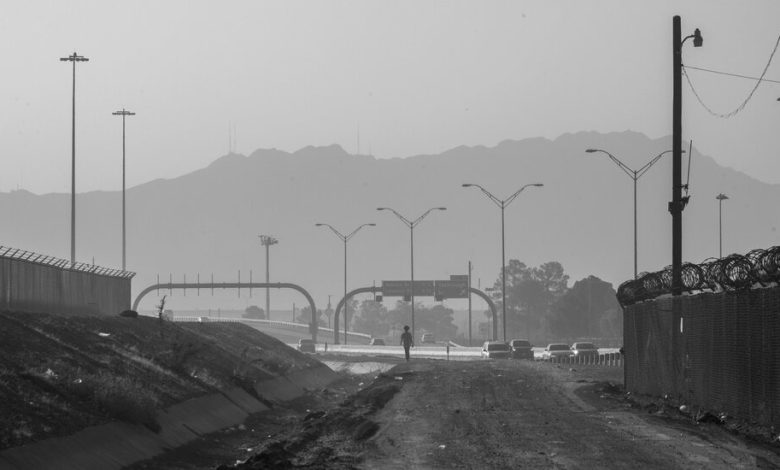Fear Is for Sale on the U.S.-Mexico Border

The U.S.-Mexico border was full of uncertainty in the days before May 11. Title 42, the Trump administration-crafted health ordinance that had been invoked millions of times to turn migrants back from the border, was about to expire, and nobody knew what to expect. Many predictions were lurid and sensationalistic: Masses of desperate people would pour into the country, flood the border towns first and then press northward.
“Right-wing media says there are 700,000 en route,” a friend texted me from the border city of El Paso. “What if true?” (It wasn’t.) The Biden administration sent 1,500 troops to help with the expected influx. Border Patrol agents handed out fliers urging migrants sleeping on El Paso’s sidewalks to surrender to custody.
Just up the road, in the middle of all that angst and all the scrambling preparations, a different kind of crowd massed in the El Paso Convention Center. These out-of-towners didn’t know what was coming, either, but they hoped to turn a profit. For a few heady days, just a short stroll from the trench where the Rio Grande draws a watery line between Mexico and the United States, law enforcement officers and salespeople played with virtual reality headsets and surveillance gadgets, spinning visions of a militarized and perfectly impenetrable border.
The speakers at the Border Security Expo included various luminaries from the Department of Homeland Security — including the Border Patrol chief, Raul Ortiz; prominent Border Patrol sector chiefs; and various Department of Homeland Security officials whose titles included words like “acquisition,” “contracting” and “procurement.”
Billed by organizers as “a valuable opportunity to demo products, talk to experts and form strategic partnerships,” the expo was, at heart, a sprawling marketplace. It could have been a dystopian suburban Tupperware party or a tidier version of a Yemeni arms market — a place to shop for everything from infrared rifle scopes to spyware to security contractors to materials for border fence sensors.
If this confluence of events sounds odd — the anticipated flesh-and-blood humanitarian crisis as a backdrop to a trade show for crises to come — you have not spent enough time along the border.
I first covered the border in the late 1990s, when walls weren’t part of the national debate and Border Patrol agents trolled deserts and river waters in a seemingly arbitrary game of cat and mouse. The national debate on immigration contemplated labor and economics, our collective values and, in a quieter but still palpable way, shifting racial demographics.
Then came the attacks of Sept. 11, 2001. The term “border security” became popular. The nation’s attention was gripped by the fear of terrorism, and everyone talked about border control. But this was just a phrase; at the border, there was little expectation that true control could ever be established — or was even sincerely desired.
The border is real, of course, the edge where two nations meet, the manifestation of laws and regulations and paperwork that govern the international movement of humans and things. But Americans have long played it like a game.
Here’s the truth: If you’re hearing about the border, it’s likely that somebody is trying to scare you. Broadly speaking, Republicans want you to be scared of immigrants, and Democrats want you to be scared of Republicans. Our fixation on terrorists has faded, but we have retained, as a legacy from that frightened era, the habit of thinking about the border as a security risk that must be mastered.
The dreaded post-Title 42 surge didn’t come. In fact, encounters between Border Patrol agents and migrants dropped 50 percent after the ordinance was lifted. But that’s not to say everything is fine. The Biden administration has now put in place a new — and harsher — set of border measures, which may or may not survive a legal challenge from immigrant rights organizations and the American Civil Liberties Union.
Behind all these maneuvers and stopgaps, the United States has no coherent immigration policy, and politicians have little motivation to discuss the issue honestly. Along with the rest of the world’s wealthy countries, we contort our laws so we can duck our treaty obligations to receive refugees.
But we don’t talk about that; instead, we talk about the border. Our southwestern frontier is not simply a geographic region; it’s a concept into which we stuff all our trepidation and disingenuousness about immigration, asylum and the economic future. We dress those complicated questions in stories of smuggling and encounters with migrants, illustrate them with images of exhausted foreigners and agents with badges.
On May 11, a representative stood in the House and announced that the border had dissolved and U.S. civilization was under threat. In March, Mr. Ortiz provoked controversy by admitting that his agency does not have complete operational control over the border. And of course, that is true. The border has never been under control.
And so there is a need — or a perception of a need — and the contractors and vendors rush to fill that gap. The carnivalesque images from the Border Security Expo, captured here by Mike Osborne, portray yet another way to imagine the border: as a business, an entrepreneur’s playground, a corporate profit center in which you can get rich in direct proportion to popular fear.
The customer is you. The customer is us. And the advertisements are all around.
The Times is committed to publishing a diversity of letters to the editor. We’d like to hear what you think about this or any of our articles. Here are some tips. And here’s our email: [email protected].
Follow The New York Times Opinion section on Facebook, Twitter (@NYTopinion) and Instagram.
Mike Osborne is a photographer based in Austin, Texas. “Federal Triangle,” a collection of his photographs shot in and around Washington, D.C., was published in 2019.
